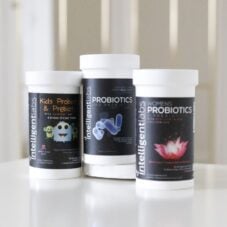Not all probiotics are the same, in fact, there can be a huge difference between one probiotic and another. Pick the right one and it can solve your health problems, or prevent health issues from occurring in the future. Pick the wrong one and probably not much will happen, apart from a possible upset stomach and wasting your money.
So what’s the deal here, with so many probiotic companies promising amazing things with their supplements, how can you really know what is a good probiotic and what isn’t? Well, here are the main 7 factors you need to look at to make a good decision.
1. The Best Probiotics Supplement – Supplement Strength
The first thing to look for when choosing a probiotic is the strength of the supplement. Probiotic strengths’ are measured in CFU’s which stands for colony-forming units. A CFU is the number of bacteria or colonies that are able to settle alive in your gut and then reproduce, per capsule or per serving, as some companies require more than one capsule to be taken at a time.
Remember to check this as it’s a sneaky way for some companies to make their supplements seem better than they actually are! CFU’s should be measured in billions. As with the number of capsules per serving, many probiotic brands will hide their strength on the back of the label making it hard to find, so be aware of this, too.
However, the best probiotic brands will clearly show their strength on the front of their labels.
Now, whilst strength is important, you can’t simply look at the strength and make a judgment. You also have to consider the number of bacterial strains there are in a supplement.
2. Best Probiotic Pills – CFU’s Per Bacterial Strain
So you should be looking at the CFU’s per bacterial strain. The objective of top probiotics is to repopulate your gut with good bacteria. To do that the bacteria needs to grow and multiply successfully.
If the strength per strain is too low, then there simply won’t be enough bacteria to cause that strain to repopulate in your gut, and change your bacterial landscape. We recommend looking for around 5 billion CFU’s per strain, so for a 10-strain probiotic supplement, that would be around 50 billion CFU’s.
It’s noteworthy that studies have shown that you need to take high strength probiotics consistently to help maintain your gut’s ecosystem. Otherwise, it will just go back to its original form.

3. The Best Probiotic Supplements Use ‘Patented Strains’
The next thing to look at is the strains themselves. We strongly recommend looking for brands that use ‘patented strains’. The importance of patented strains is probably still the best-kept secret in the world of probiotics.
A patented strain is one that has been extensively researched for its health benefits, so that it’s given a specific name, or as we will see in the following paragraphs, a specific number. Conversely, an unpatented strain is one that has no research behind it, so you can never be sure of its exact effects. Unpatented strains are still used by the majority of probiotic companies because they are much cheaper.
So how do you know what’s patented and what isn’t? It’s actually easy, you just look for a number after each strain listed on the back of a probiotic label. But let me explain how it works a bit further. Let’s look at the example of the most common bacterial strain in probiotics – Lactobacillus acidophilus. In actual fact, Lactobacillus acidophilus isn’t technically a strain. Lactobacillus is the genus or family of the strain, and Acidophilus is the species of the strain. The actual strain is defined by a number. For example, in our probiotic it’s La-14. So the full title of the strain is Lactobacillus Acidophilus La-14.
The easiest way to understand this is to think of dogs. The Genus or Family of a dog is a canine that includes dogs, coyotes, dingoes, wolves, jackals, etc. The species (i.e Acidophilus) is a dog, however, the strain is equivalent to the breed of the dog, i.e a pug or an Alsatian.
So whilst Alsatians and Pugs are both dogs, there are obviously big differences between them. It’s the same for a probiotic. Because most companies just list Lactobacillus acidophilus on their bottles with no defining number, it means they are using cheap generic strains that cannot be properly identified, which makes it impossible to judge their real health benefits.
With a ‘specific strain number’ listed on the bottle of a probiotic, you can immediately identify the specific strain and easily look at the exact research that’s been done on it. When brands don’t list patented strains it’s a big red flag. Patented strains will be specifically selected for their ability to withstand your stomach acid and bile, so they won’t die off as they pass through your digestive system. With unpatented strains, it’s not possible to know whether they are acid and bile resistant and likely to survive the journey.

4. Get the Best Probiotic Pills – Enteric Coated or Delayed Release
The best probiotics supplements will also use a specially coated pill, whether it’s ‘enteric-coated’ or a ‘delayed-release’ capsule. This means that the capsule doesn’t dissolve as soon as it enters your stomach, which would expose the probiotics to stomach acid and bile. Now, we’ve already mentioned strains should be chosen for their ability to withstand acid and bile. But nothing in life is 100%, so using an enteric or delayed-release capsule is just a bit of extra insurance to make sure that the bacteria gets through to your large intestine alive.
5. Quality Probiotics Shouldn’t Need Refrigeration
Many brands out there require their probiotics to be refrigerated. However, this is an indication of using low-quality strains. Quality strains will all be able to withstand normal temperatures (you should always store your probiotics in a cool dry place). One of the big issues with probiotics that require refrigeration is that when they leave their manufacturing facility they won’t be refrigerated during transportation, and during the time they spend hanging around in warehouses.
This time period can be anywhere from a few weeks to a few months, so during that time their strength will be constantly weakening as the bacteria die off, and consequently, they will be far less effective.

6. Probiotics Need Prebiotics
Prebiotics are food for probiotics. A quality probiotic brand should always manufacture a capsule that contains prebiotics as well as probiotics. The prebiotics ensure that the probiotics are nourished when they are in the capsule, so they are still alive when you take them. They also help to feed the probiotics once they are in your gut. Check each brand to make sure it comes with prebiotics.
7. Third-Party Independent Testing
A final factor in judging what is the best probiotic to take is whether a company makes third party independent testing certificates available. It’s all very well for them to advertise something on the bottle or in their sales literature. But how do you really know you are actually getting what they say you are getting, especially when research has shown that up to 30% of companies don’t actually provide the strength of probiotics they say they do? That’s where third-party testing comes in. All reputable companies should provide these certificates on demand, or better still, post them up on their websites / sales pages.
So there you have the top 7 factors to look for when choosing a probiotic. If a brand satisfies all of these, then you can be sure you’re getting a quality product. For the best probiotics that fulfill all these criteria, check out our 50 Billion CFU Adult Probiotics and Prebiotics, Women’s Probiotics and Prebiotics, and Kids Probiotics and Prebiotics.





